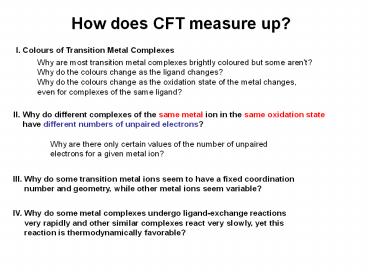How does CFT measure up? - PowerPoint PPT Presentation
Title:
How does CFT measure up?
Description:
Why do the colours change as the oxidation state of the metal changes, ... Stability and lability. Substitution reactions. Electron transfer reactions ... – PowerPoint PPT presentation
Number of Views:119
Avg rating:3.0/5.0
Title: How does CFT measure up?
1
How does CFT measure up?
I. Colours of Transition Metal Complexes
Why are most transition metal complexes brightly
coloured but some aren't? Why do the colours
change as the ligand changes? Why do the colours
change as the oxidation state of the metal
changes, even for complexes of the same ligand?
II. Why do different complexes of the same metal
ion in the same oxidation state have
different numbers of unpaired electrons? Why
are there only certain values of the number of
unpaired electrons for a given metal ion?
III. Why do some transition metal ions seem to
have a fixed coordination number and
geometry, while other metal ions seem variable?
IV. Why do some metal complexes undergo
ligand-exchange reactions very rapidly and
other similar complexes react very slowly, yet
this reaction is thermodynamically
favorable?
2
Course Outline
- Introduction to Transition Metal Complexes.
- Classical complexes (Jorgenson and Werner)
- Survey of ligand coordination numbers,
geometries and types of ligands - Nomenclature
- Isomerism
- Bonding in Transition Metal Complexes.
- Electron configuration of transition metals
- Crystal field theory
- Valence bond theory
- Simple Molecular Orbital Theory
- Electronic Spectra and Magnetism
- Kinetics and Mechanisms of Inorganic Reactions.
- Stability and lability
- Substitution reactions
- Electron transfer reactions
- Descriptive Chemistry of TMs.
- Organometallic Chemistry
- 18 e- rule, ?, and ? bonding ligands
(synergistic bonding) - Metal carbonyls, synthesis, structure,
reactions
3
18- Electron Rule.
The 18-electron Rule is based on a similar
concept.
The central TM can accommodate electrons in the
s, p, and d orbitals. s (2) , p (6) , and d (10)
maximum of 18 This means that a TM can add
electrons from Lewis Bases (or ligands) in
addition to its valence electrons to a total of
18. This is also known Effective Atomic Number
(EAN) Rule
Note that it only applies to metals with low
oxidation states.
4
18 Electron Rule contd
Example 1. Co(NH3)63
Oxidation state of Co? Electron configuration of
Co? Electrons from Ligands? Electrons from
Co? Total electrons?
Example 2. Fe(CO)5
Oxidation state of Fe? Electron configuration of
Fe? Electrons from Ligands? Electrons from
Fe? Total electrons?
What can the EAN rule tell us about Fe(CO)5?
It cant occur 20-electron complex.
5
EAN Summary
- Works well only for d-block metals. It does not
apply to f-block metals. - Works best for compounds with TMs of low ox.
state. - Ligands which are good ?-donors and p-acceptors
utilize all the valence orbitals and thus such
compounds obey this rule. - Complexes which contain a combination of ?-donors
and p-acceptors conform to this rule. (e.g.
Cr(NH3)3(CO)3 , Cr(?6-C6H6)(CO)3). - Compounds which obey this rule are kinetically
inert to substitution reactions. - Exceptions to the rule occur at the two ends of
the transition series where nd, (n1)s, and
(n1)p valence orbitals are less well matched in
energy.
Lets talk about electron counting briefly.
6
Sandwich Compounds Obeying EAN
Lets draw some structures and see some new
ligands. Each of these ligands is ?-bonded above
and below the metal center.
Ferrocene is an interesting example.
Half-Sandwich Compounds Obeying EAN
Lets draw some more structures.
CO, NO, H, and PR3 can be brought together in
combination to give 18 electrons.
7
Some other cool ligands.
These cyclic ligands need not be planar. Here
are some examples of compounds of
cyclooctatetraene.
Can a reaction involve only compounds which obey
the 18 electron rule? YES.
8
Compounds and the EAN Rule
- We can divide compounds into three groups.
- Electronic configurations are completely
unrelated to the EAN rule. The central metal may
have gt, lt, 18 electrons. - Electron configurations follow the EAN rule and
never have gt18 electrons, but may have less. - A group that follows EAN rule rigorously.
- How can we understand this?































